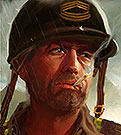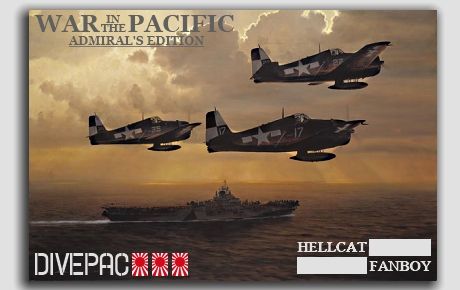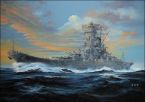Tiornu
Posts: 1126
Joined: 4/1/2004
Status: offline

|
The fuze delays on Japanese shells were literally ten times longer than in most foreign fuzes. That greatly increases the chances for through-and-throughs if you don't hit something solid. Sadly for Johnston, the shells hit a boiler and engines--all three shells detonated on board. The ship's response to the hits was more pronounced than you see in the other Samar DD large-caliber hits. The shock was so great that it snapped the master gyro frame in half, a fact so unusual that BuShips didn't want to believe it. After all, the thing was designed to withstand a shock of 2000 ft-lbs. Well, guess what...?
At the time when Johnston was hit, Haruna was not firing her main battery. Nagato also had checked fire but was preparing her secondaries to open fire. Kongo's main rangefinder was out of action, and she too checked fire before the Johnston hits. However, Yamato reported firing on and hitting an American cruiser at that time.
Now, we all know that action reports are not perfect, so there is some possibility that the timelines are sufficiently inaccurate to allow other possibilities. Nagato makes no claims of a hit during this period, and even if her chronology is shifted a few minutes, she checked fire some minutes before Yamato's "cruiser" got hit. Haruna likewise makes no hit claims and her chronology would have to be seriously off, by ten minutes or more, to match the hit with her reported gunnery. Kongo did claim hitting a destroyer, but it was about 13 minutes off.
Johnston's report describes her hits as 14in, and this is the only source for that caliber. BuShips, as I recall, didn't believe it and speculated it was actually 8in. You may recall that North Carolina was hit by a torpedo with 660 lbs of explosive...or so say the official reports. We now know the charge was 50% larger than that, but they were going with what they understood at the time. Ah, let me correct something. BuShips said the hits were 7.87in, because they thought IJN cruisers were still using 200mm guns. Sometimes intelligence ain't so intelligent. (I just made a comment on 200mm guns in another thread. I think the only ships still using the gun after 1939 were the Thai coast defenders, Kaga, and Akagi. One of the Furutakas still had its original guns but bored out to 203mm.) The BuShips claim was based on descent angles. In fact, BuShips was mistaken about the relative positions of the ships, and the descent angle they site actually favors the battleships over cruisers. Specifically it favors Yamato, who was closer than Kongo and whose guns fired at a lower trajectory at any given range.
Anyway, it's Johnston's claimed caliber that has caused historians to favor Kongo. In fact, Johnston does not say simply that they were 14in: "Ship sustained first hits which were composed of a salvo of three 14" or 16" projectiles...." Keep in mind that Yamato supposedly had 16in guns. The Johnston report actually allows for the culprit to be any of the four Japanese battleships.
If we ignore the timelines, we're left with two ships claiming hits that might be Johnston. Yamato was nearer, thus more likely to hit and better matching the estimated descent angle. The three-shell salvo favors Yamato, and we can also note the three "6-inch" hits that followed the big shells. There is nothing to favor Kongo except our disbelief that Johnston could survive three 3219-lb hits. But it sure likes she did.
Maybe further research and analysis will uncover something conclusive, but I think the evidence points to Yamato.
|
 Printable Version
Printable Version



















 New Messages
New Messages No New Messages
No New Messages Hot Topic w/ New Messages
Hot Topic w/ New Messages Hot Topic w/o New Messages
Hot Topic w/o New Messages Locked w/ New Messages
Locked w/ New Messages Locked w/o New Messages
Locked w/o New Messages Post New Thread
Post New Thread